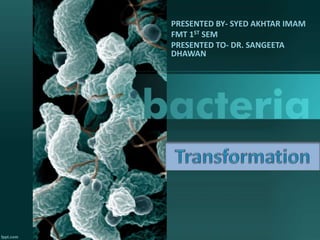
Transformation
- 1. PRESENTED BY- SYED AKHTAR IMAM FMT 1ST SEM PRESENTED TO- DR. SANGEETA DHAWAN
- 2. INTRODUCTION Transformation is the genetic alteration of a cell resulting from the direct uptake and incorporation of exogenous genetic material from its surroundings through the cell membrane. Transformation is one of three processes for gene transfer , in which exogenous genetic material passes from one bacterium to another.
- 3. The other two are transduction(carried out by means of bacteriophage) & conjugation(gene is passed through direct contact between bacteria). In transformation, the genetic material passes through the intervening medium, and uptake is completely dependent on the recipient bacterium.
- 5. In this image, a gene from bacterial cell 1 is moved from bacterial cell 1 to bacterial cell 2. This process of bacterial cell 2 taking up new genetic material is called transformation.
- 6. HISTORY Transformation in bacteria was first demonstrated in 1928 by the British bacteriologist Frederick Griffith. It was the first experiment suggesting that bacteria are capable of transferring genetic information through a process known as transformation. Griffith's findings were followed by research in the late 1930s and early 40s that isolated DNA as the material that communicated this genetic information. Pneumonia was a serious cause of death in the wake of the post-WWI Spanish influenza pandemic, and Griffith was studying the possibility of creating a vaccine. Griffith used two strains of pneumococcus (Streptococcus pneumoniae) bacteria which infect mice – a type III-S (smooth) which was virulent, and a type II-R (rough) strain which was nonvirulent.
- 7. The III-S strain synthesized a polysaccharide capsule that protected itself from the host's immune system, resulting in the death of the host, while the II-R strain did not have that protective capsule and was defeated by the host's immune system. Bacteria from the III-S strain were killed by heat, and their remains were added to II-R strain bacteria. While neither alone harmed the mice, the combination was able to kill its host. Griffith was also able to isolate both live II-R and live III-S strains of pneumococcus from the blood of these dead mice. Griffith concluded that the type II-R had been "transformed" into the lethal III-S strain by a "transforming principle" that was somehow part of the dead III-S strain bacteria. we know that the "transforming principle" Griffith observed was the DNA of the III-s strain bacteria. While the bacteria had been killed, the DNA had survived the heating process and was taken up by the II-R strain bacteria. The III-S strain DNA contains the genes that form the smooth protective polysaccharide capsule. Equipped with this gene, the former II- R strain bacteria were now protected from the host's immune system and could kill the host.
- 10. Mechanism o The bacterial which is able to get transformed is called competant bacteria. o The competant bacteria produces a protein called competant factor. o The competant factor molecule combines with the plasma membrane of the bacteria binds to the cell surface of bacteria. o This combination causes the production of a special type of protein called autolysin.
- 11. o This autolysin exposes DNA binding protein and exonuclease present on the cell membrane of the bacteria. o When foreign DNA comes in contact with the competant bacterium, the DNA molecules get fragmented. o One of the strands of the foreign DNA segment is gradually cut into nucleotides. o The liberated by the cut nucleotides is used for the entrance of the other intact strand. o The intact single strand of DNA pairs with the homologous region of the recipient DNA of recipient bacteria.
- 12. o By crossing over at two sites between the homologous DNA of donar and recipient bacteria, the foreign DNA gets incorporated with the donar DNA. o When such foreign DNA segment containing recipient bacterium undergoes DNA replication, two bacteria are produce one has original dsDNA and other has a part foreign DNA joint to its own DNA.
- 15. Types of transformation Natural transformation o Natural transformation is a bacterial adaptation for DNA transfer that depends on the expression of numerous bacterial genes whose products appear to be responsible for this process. o In general, transformation is a complex, energy-requiring developmental process. In order for a bacterium to bind, take up and recombine exogenous DNA into its chromosome, it must become competent, that is, enter a special physiological state.
- 17. ARTIFICIAL TRANSFORMATION Artificial competence can be induced in laboratory procedures that involve making the cell passively permeable to DNA by exposing it to conditions that do not normally occur in nature. Typically the cells are incubated in a solution containing divalent cations (often calcium chloride) under cold conditions, before being exposed to a heat pulse (heat shock). Calcium chloride partially disrupts the cell membrane, which allows the recombinant DNA enter the host cell.
- 18. The most common method of artificial transformation of bacteria involves use of divalent cations (e.g., calcium chloride) to increase the permeability of the bacterium’s membrane, making them chemically competent, thereby increasing the likelihood of DNA acquisition. Another artificial method of transformation is electroporation, in which cells are shocked with an electric current, to create holes in the bacterial membrane. With a newly-compromised cell membrane, the transforming DNA is free to pass into the cytosol of the bacterium.
- 19. Regardless of which method of transformation is used, outgrowth of bacteria following transformation allows repair of the bacterial surface and selection of recombinant cells if the newly acquired DNA conveys antibiotic resistance to the transformed cells.